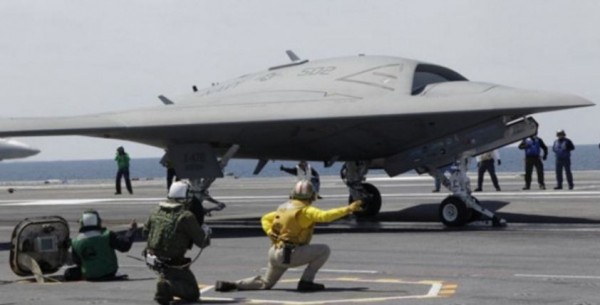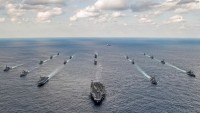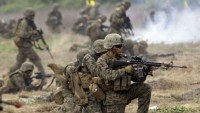US Navy’s First Carrier Aerial Drone Morphs into Multi-mission Aircraft
| Arthur Dominic Villasanta | | Dec 14, 2016 07:29 AM EST |
(Photo : US Navy) Unmanned MQ-25 about to launch itself from a U.S. Navy carrier.
The MQ-25 Stingray, the U.S. Navy's first carrier-based unmanned aerial drone, should finally see service with the navy by the next decade as a versatile, multi-mission aircraft supporting strike operations.
The first key step towards this goal, a draft request for proposal for the Stingray, will likely be issued this December. The final RFP (this for the air segment) will be issued in early 2017 to Boeing, Northrop Grumman, Lockheed Martin and General Atomics.
Like Us on Facebook
The Navy plans to have the final MQ-25 design by 2018 and receive its first operational Stingrays by 2021.
The Stingray has had a checkered history with the navy. Originally designated as the X-47B, the drone is a tailless jet-powered blended-wing-body aircraft capable of semi-autonomous operation that first flew in 2011. It was designed to take-off and land autonomously on aircraft carriers.
The X-47B was made by Northrop-Grumman and specifically designed for aircraft carrier-based operations. Northrop-Grumman wanted the prototype X-47B to enter service as the Unmanned Carrier-Launched Airborne Surveillance and Strike (UCLASS) system, which was to have begun operations with the U.S. Navy in the 2020s.
The cancellation of the UCLASS project, however, killed any hope the X-47B would have entered Navy service as the "Stingray" reconnaissance and attack drone.
"We kind of revamped our strategy," said U.S. Navy Chief of Naval Operations Admiral John Richardson last February. "It has a legitimate role in terms of tanking, and I would say that (intelligence, surveillance and reconnaissance) is on the table, for sure."
Downgrading the Stingray to the role of an aerial tanker with reconnaissance capabilities marks an inglorious end to the combat version of this aerial drone that was to have changed the face of aerial warfare by proving drones could survive high-intensity aerial combat.
As the MQ-25, the former Stingray's initial mission was to be "recovery tanking" in which it refuels planes flying in a fixed orbit around an aircraft carrier.
This method will allow Navy combat jets such as Boeing F/A-18E/F Super Hornets and Northrop Grumman F-35 Joint Strike Fighters to fly missions with enough fuel to return to their mother carriers.
The Navy currently has no purpose-built refueling tanker that can land on and take-off from a carrier. It wants its MQ-25 drone tankers to carry up to 10,000 pounds of fuel on each flight.
The drone received its final MQ-25 Stingray in July, with the prefix MQ indicating it to be a multi-mission unmanned aerial vehicle.
That multi-mission for the MQ-25 now consists of aerial refueling, reconnaissance drone and a limited strike capability.
TagsMQ-25 Stingray, U.S. Navy, carrier-based unmanned aerial drone, Unmanned Carrier-Launched Airborne Surveillance and Strike (UCLASS) system
©2015 Chinatopix All rights reserved. Do not reproduce without permission
EDITOR'S PICKS
-

Did the Trump administration just announce plans for a trade war with ‘hostile’ China and Russia?
-

US Senate passes Taiwan travel bill slammed by China
-

As Yan Sihong’s family grieves, here are other Chinese students who went missing abroad. Some have never been found
-

Beijing blasts Western critics who ‘smear China’ with the term sharp power
-

China Envoy Seeks to Defuse Tensions With U.S. as a Trade War Brews
-

Singapore's Deputy PM Provides Bitcoin Vote of Confidence Amid China's Blanket Bans
-

China warns investors over risks in overseas virtual currency trading
-

Chinese government most trustworthy: survey
-

Kashima Antlers On Course For Back-To-Back Titles
MOST POPULAR
LATEST NEWS
Zhou Yongkang: China's Former Security Chief Sentenced to Life in Prison

China's former Chief of the Ministry of Public Security, Zhou Yongkang, has been given a life sentence after he was found guilty of abusing his office, bribery and deliberately ... Full Article
TRENDING STORY

China Pork Prices Expected to Stabilize As The Supplies Recover

Elephone P9000 Smartphone is now on Sale on Amazon India

There's a Big Chance Cliffhangers Won't Still Be Resolved When Grey's Anatomy Season 13 Returns

Supreme Court Ruled on Samsung vs Apple Dispute for Patent Infringement

Microsoft Surface Pro 5 Rumors and Release Date: What is the Latest?













